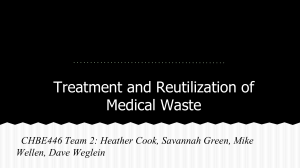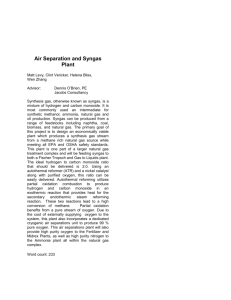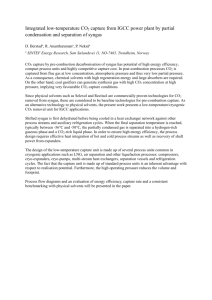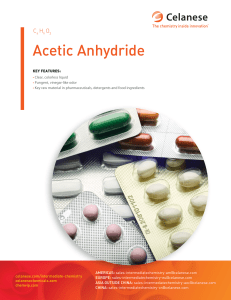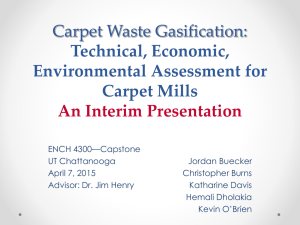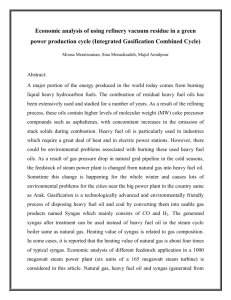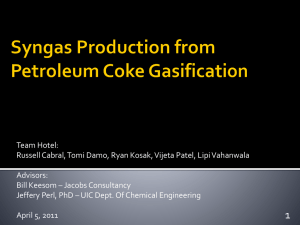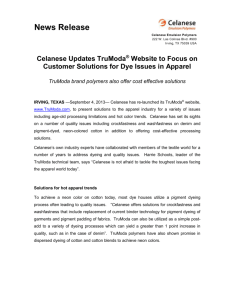1
advertisement
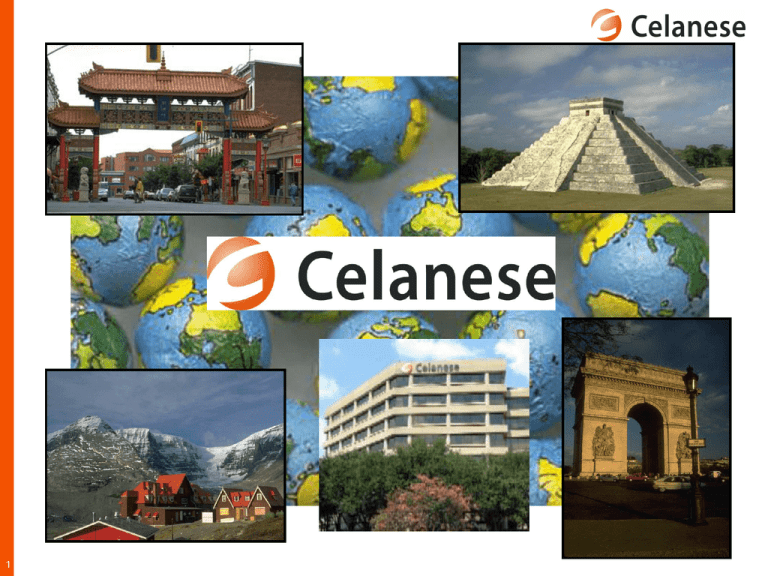
1 Industrial Chemistry Class Texas A&M University March 6, 2006 Where is Celanese? 3 Celanese Today Attractive hybrid business model Leading global producer position Clear advantage in technology and costs Opportunities for savings and synergies Sales by Segments* Chemicals Ticona Acetate Performance 66% 16% 14% 4% Sales by Regions* North America Europe Asia 40% 40% 20% 2005 sales: 2005 employees: $ 6.1 bn ~9,300 Strong leading business 4 *Percentage of 2005 Celanese projected net sales and Celanese share of equity and cost investments. Strategic Growth Region Asia Tomorro w 33% of Sales in Asia Korea Engineering Plastics Nantong Cellulose Fibers Co. Zhuhai and Kunming Fibers Co. Polyplastics Continue with joint ventures Nanjing Complex Nanjing Acetyl Complex, China New GUR plant KEPCO, Polyplastics subsidiary, Taiwan. Polyplastics, Malaysia Celanese Chemicals, Singapore Building our presence in growth regions 5 Vision for continued future growth Performance Ticona Technical Polymers Cash Drivers Building Blocks Celanese Emulsions, Polyvinyl Alcohol 6 Automotive, E+E, Medical Devices Adhesives, Paints, Coatings, Paper Acetyls Basic Chemicals Celanese Acetate Nutrinova Performance Products Markets Synthesis Gas in Celanese Methanol Formaldehyde PE, BG, and TMP Polymers Acetic Anhydride Synthesis Gas 7 Carbon Monoxide Acetic Acid Vinyl Acetate PVOH Butyraldehyde Butanol Butyl Acetate Propyl Acetate Propionaldehyde Propanol Heptanal Heptanoic Acid Nonanal Perlargonic Acid Emulsions Paths to Synthesis Gas Steam Reforming - Methanol - H2 supply for Alcohols Partial Oxidation - CO supply for Acetic Acid - Syngas supply for Aldehyde Coal Gasification - CO supply for Acetic Acid 8 Syngas from Steam Reforming 9 CH4 H 2O CO 3H 2 H 298 49.27kcal / mole CO H 2O CO2 H 2 H 298 9.84kcal / mole CO2 fed to drive water gas shift reaction towards CO Nickel catalyst Desulphurization of Methane Feedstock Endothermic – heat supplied by burning Methane Higher cost source of syngas for Celanese Primarily used for production of Methanol Syngas from Steam Reforming CH4 Steam CO2 CO2 Syngas Reformer Fuel Gas Air Quench Pot Absorber Stripper Gas Purification (amine) Conversion dependent on steam:carbon ratio, temperature, and pressure Typical furnace is box-like, numerous catalyst filled tubes Reformer Temperature – ~1450 F Reformer Pressure - ~130 psig Amine used to remove acid gases (primarily CO2) 1 Syngas from Partial Oxidation CH4 1/ 2O2 CO 2H 2 Heat CH4 2O2 CO2 2H 2O Heat CO H 2O CO2 H 2 1 (Water Gas Shift Reaction) No catalyst Reacted at high temperatures under conditions of insufficient O2 Exothermic – steam generated from heat CO2 can be fed to drive water gas shift reaction towards CO Primary source of syngas for Celanese Used for raw material feed to Acetic Acid and Oxo Units Syngas from Partial Oxidation CH4 O2 Stripper Absorber Scrubber CO2 Syngas Reactor WHB Gas Purification (amine) 1:1 CO:H2 Syngas H2 Membrane 99% CO Syngas H2 Coldbox Oxygen/CH4 ratio is important to prevent high temperature or soot conditions Reactor Temperature – ~2500 F Reformer Pressure – 800+ psig Amine used to remove acid gases (primarily carbon monoxide) Membranes or coldbox is used to modify CO/H2 composition 1 Syngas from Coal Gasification C H 2O CO H 2 C 1/ 2O2 CO CO H 2O CO2 H 2 1 No catalyst Exothermic Reaction adjusted through WGS to increase H2 Future source of syngas for Celanese in China Coal Gasification Sulfur Coal by Railcar Coal Storage/ Grinding/Slurry Prep Sulfur Recovery (2 100% Trains) Oxygen Gasification (2 100% Trains) Slag and Fines Handling Gas Cooling Acid Gas Removal CO to Acetic Acid Unit Cold Box Syngas Steam Ash Reactor temperatures can operate between 1650 and 2750 F Similar purification steps to remove CO2 and adjust H2 composition Additional process steps required to handle ash and sulfur Additional steps required for handling solid raw material 1 H2 Sales Synthesis Gas in Celanese Methanol Formaldehyde PE, BG, and TMP Polymers Acetic Anhydride Synthesis Gas 1 Carbon Monoxide Acetic Acid Vinyl Acetate PVOH Butyraldehyde Butanol Butyl Acetate Propyl Acetate Propionaldehyde Propanol Heptanal Heptanoic Acid Nonanal Perlargonic Acid Emulsions Reliability Sensitivity What happens if syngas on-stream reliability (OSR) is poor? Hypothetical Example: Unit producing 2,000 mT/day of acetic acid. Revenue of $100/mT. What is revenue benefit of 98.5% OSR versus 95% OSR? 2,000mT / d 365d / yr .985 .95 $100 / mT ~ $2.5MM / yr 1 n2 Ap 00 r-2 0 Ju 000 l-2 O 00 ct 0 -2 Ja 00 n- 0 2 Ap 00 r-2 1 Ju 001 l-2 O 00 ct 1 -2 Ja 00 n- 1 2 Ap 00 r-2 2 Ju 002 l-2 O 00 ct 2 -2 Ja 00 n- 2 2 Ap 00 r-2 3 Ju 003 l-2 O 00 ct 3 -2 Ja 00 n- 3 2 Ap 00 r-2 4 Ju 004 l-2 O 00 ct 4 -2 Ja 00 n- 4 2 Ap 00 r-2 5 Ju 005 l-2 O 00 ct 5 -2 Ja 00 n- 5 2 Ap 00 r-2 6 Ju 006 l-2 O 00 ct 6 -2 00 6 Ja $ / Barrel 1 $70.00 $14.0 $60.00 $12.0 Sept. 11th $50.00 $10.0 $40.00 $8.0 $30.00 $6.0 $20.00 $4.0 $10.00 $2.0 $$- Month Crude Oil ARAC Natural Gas $ / MM BTU Fossil Fuel Pricing Crude Oil & Natural Gas - N. America Katrina / Rita Natural Gas Pricing $ / MM BTU $2.5 / MM BTU $8-14 / MM BTU $1.0 / MM BTU $1.5 / MM BTU 2001 Price 2005 Price 1 Chemical Market Associates, Inc., 2005 $4.0 / MM BTU $5.5 / MM BTU $4.5m South America What does it take to remain competitive? 1 Career Path - Jon Makelki Process Engineer Bishop Plant 1998 Co-op/Intern 6 Sigma Black Belt Bishop Plant Bishop Plant 1996 2001 Production Engineer Clear Lake Plant 2002 2 Manufacturing Leader Enhancement Engineer Bay City Clear Lake, Singapore, China 2005 2003 Career Path – David Trueba Process Chemist Process Chemist Carbon Monoxide – Clear Lake Acetic Acid / Vinyl Acetate – Clear Lake 2001 2001 6 Sigma Black Belt Clear Lake Plant 2004 Global Commodity Leader Raw Materials July 2005 2 Performance Enhancement Program (Purchasing) Dallas Global HQ Nov 2004 Conclusion Syngas - basic building block for the industry Raw materials & end use drive technology application Chemical Market is challenging and mature - Drive down costs - Improve reliability - Drive Innovation 2 For more information Visit with your Celanese Key Recruiter – Jeff Kirkpatrick-> Jrkirkpatrick@celanese.com Look us up on campus in the Fall – Student Engineering Council Career Fair – Sept. 2006 – Informational Meeting / On-campus interviews - Oct 2006 www.celanese.com 2
